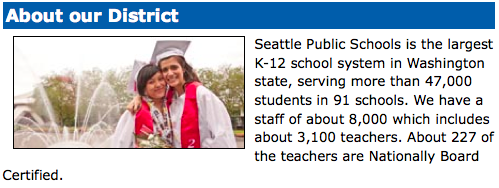 The Seattle City Council has unanimously approved putting the $231 million Families & Education Levy on the November ballot. As Publicola reports, this roughly doubles “the amount a typical Seattle homeowner will pay for early-learning and youth services to an average of $124 per year, compared to $65 a year under the last levy, adopted in 2004.”
The Seattle City Council has unanimously approved putting the $231 million Families & Education Levy on the November ballot. As Publicola reports, this roughly doubles “the amount a typical Seattle homeowner will pay for early-learning and youth services to an average of $124 per year, compared to $65 a year under the last levy, adopted in 2004.”
The 7-year levy addresses the extra needs of Seattle’s 23 Title I schools, says Seattlepi.com, which have more students from poorer families. To supplement what the school district alone can provide, the city levy will fund programs “from pre-school to high school, including continuing to provide pre-school space, at-home early learning skills, support for at-risk students, summer learning programs and expand school-based health centers.”
Despite that 9-0 vote, the levy is not uncontroversial. That in itself is controversial, because Seattle voters have rarely met an education levy they didn’t overwhelming like. A poll shows that the spirit is willing but the wallet is weak: two-thirds of voters approve of the levy and its purpose, but only one-third could stomach the $231 million price tag.
The Council’s Tim Burgess is a vocal proponent of the levy, and he and Mayor McGinn have been, unusually, on the same page regarding their response to raising more money while a school superintendent has just been relieved of duties for her lack of financial oversight: The levy’s funds will be disbursed and overseen by the city, not the school district, so you can have confidence that they are going to the right place.
 That does not address the counterargument that, in theory, the school district should be able to fund its schools–needy and less needy–without the city resorting to a semi-eternal levy. (The Families and Education Levy was first approved in 1990, extended in 1997, and again in 2004.) Those of a more skeptical nature might ask whether, as the city demonstrates a willingness to shoulder the extra burden, the school district is not reallocating funds in anticipation of that.
That does not address the counterargument that, in theory, the school district should be able to fund its schools–needy and less needy–without the city resorting to a semi-eternal levy. (The Families and Education Levy was first approved in 1990, extended in 1997, and again in 2004.) Those of a more skeptical nature might ask whether, as the city demonstrates a willingness to shoulder the extra burden, the school district is not reallocating funds in anticipation of that.
Most Seattleites, I think, would not argue with Burgess about the importance of what the levy means to do. The poll would seem to suggest that. Burgess writes, compellingly:
Consider a young student from a Seattle family living in poverty. When she enters kindergarten, she has slightly better than a 50-50 chance of reading at grade level in the 3rd grade. From the beginning, she has only a 60 percent chance of graduating from high school on time. But, it gets worse. If she fails a core subject in 6th grade, her high school graduation chances fall below 50 percent. In high school, she has a 1 in 3 chance of believing she has been tagged by teachers as “not college material.”
 Besides the recent financial scandal, there is the more core-competency test of the district’s ability to lead in education. The latest news there is that the Washington Court of Appeals has, on legal grounds, struck down the challenge to the district’s choice of a “discovery” math curriculum on the grounds that (I editorialize slightly) the district did due diligence before choosing badly.
Besides the recent financial scandal, there is the more core-competency test of the district’s ability to lead in education. The latest news there is that the Washington Court of Appeals has, on legal grounds, struck down the challenge to the district’s choice of a “discovery” math curriculum on the grounds that (I editorialize slightly) the district did due diligence before choosing badly.